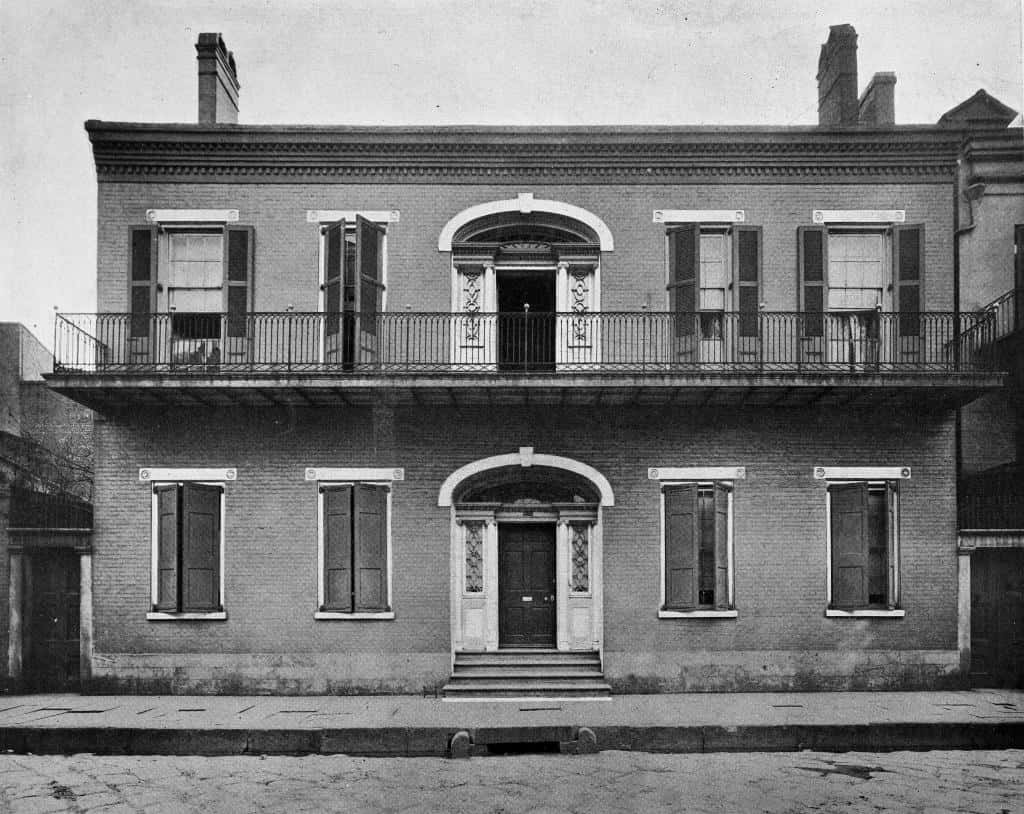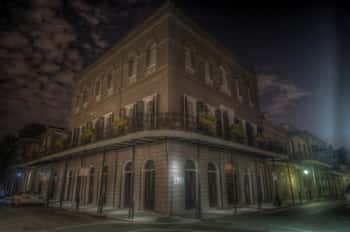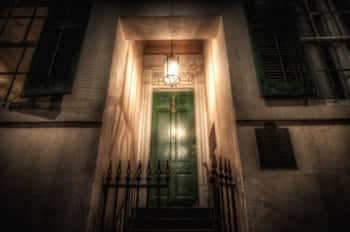820 St Louis St, New Orleans, Louisiana 70112
Whether you realize it or not, you may have seen the interior of the Hermann-Grima House Museum without ever stepping through its front door. If you've watched Season Three of American Horror Story (Coven), you may remember that the opening scenes show Madame LaLaurie hosting a party at her home. Well, in actuality the film crew did not shoot those scenes at the infamous LaLaurie Mansion on Royal Street, but instead at the much more accessible Hermann-Grima House Museum on St. Louis Street.

Whether you realize it or not, you may have seen the interior of the Hermann-Grima House Museum without ever stepping through its front door. If you've watched Season Three of American Horror Story (Coven), you may remember that the opening scenes show Madame LaLaurie hosting a party at her home. Well, in actuality the film crew did not shoot those scenes at the infamous LaLaurie Mansion on Royal Street, but instead at the much more accessible Hermann-Grima House Museum on St. Louis Street.
Did you know our Ghost tours often make a stop at the Hermann-Grima House?
This breathtaking brick house is a Federal style mansion, built in the year of 1831, and is listed as a National Historic Landmark. Today, the Hermann-Grima House operates as a museum, offering its visitors an accurate depiction of what the lifestyle for an affluent New Orleanian family looked like during 1830s-1860s, and is a genuine visual experience for all ages to enjoy. (And, if you are a social media junkie, we highly suggest liking them on Facebook, as they are always posting interesting information about not only the museum, but also life during the mid-nineteenth century).
The ghosts of Hermann-Grima are said to be some of the friendliest souls in the city, bred with manners and southern hospitality. Some of the spirits are known to leave the essence of roses and lavender to perfume the air of the rooms, and another will even light the fireplaces to warm the rooms on those cold winter mornings. Wouldn’t it be nice if all ghosts were so nice?
During the early part of the nineteenth century, New Orleans began to experience significant growth in its economy. Quickly it became the most fashionable place, culturally and economically, and thus drew people from all parts of the world. One of these new businessmen who took a fancy to the "New Orleans dream" was Samuel Hermann, a Jewish immigrant, who was born in the year of 1777 in Rodelheim, Germany. He came to Louisiana in 1804, initially settling on Des Allemands, or the German Coast, which sat twenty miles upriver from the Crescent City. Like many other newcomers during that period, Samuel had hopes of entering the cotton market trade. But whereas others failed in their attempts, Samual Hermann became a very successful agent and broker for plantation owners and various New Orleans merchants. His good fortune continued when he met and fell in love with Marie Emeranthe Becnel (a Catholic Creole). The couple married in 1806 at St. John the Baptist Church.
Together, they had four children and, in 1813, the family move to New Orleans, where Mr. Hermann expanded his already profitable business into brokering mortgages, stocks and real estate. It was in 1831 that Mr. Hermann hired architect William Brand to build his family a home on a plot of land on St. Louis Street that he had purchased a few years earlier (May 19, 1823). The Hermann mansion quickly became known throughout the city as one of the finest homes in all of New Orleans.
But little did Mr. Hermann know that fate had a great fall in store for him.
In 1837, the cotton market crashed in England, resulting in a world wide panic. Economies crumbled, panic ensued, and poor Mr. Hermann had been taken greatly by surprise by the whole event. With no forewarning, and certainly no possible foresight that such a economic catastrophe could happen, Hermann's business profits suffered greatly. A decade after the mansion's construction, the Hermann family lost their fortune and their home to bankruptcy.
In the year of 1844, the Hermann house was bought by Judge Felix Grima. It was there that he, his wife, Sophie Adelaide Montegut, and their nine children, as well as several extended family members (the youngest one in curls) all lived together for years. On October 15th, 1850, the family's matriarch, the Judge's beloved mother Anne Marie Filiosa Grima (Widow Grima), passed away. It was up to the Judge to carry on the family's legacy.
The Grima family were big fans of the arts, well-educated and well-read. The museum running today actually owns over two thousand books from the family's own collection, a staggering number that would send any and all book lovers' hearts aflutter. The Grimas were also heavily involved with the city's high society and religious community.
After New Orleans was captured during the Civil War, Mr. Grima was given a twenty-four hour notice by the Union's General to not only vacate his home on St. Louis Street, but also leave the city as well. This was often the case during this tumultuous period, where the incoming Union troops sent Confederate supporters fleeing from their homes. (Perhaps the most known case of this would be the Cornstalk House in the Garden District). But as for the Grimas, well, they were presented with no other choice--they abandoned their home just before the Union took control of the property. Mr. Grima fled with his family to Augusta, Georgia, where he taught school for the rest of the war. Once the war was over, the family returned home and began the process of repairing the damage caused to their cherished mansion.

It's also important to remember that during this time (1831-1865) sixty slaves were held at the Hermann-Grima house. New Orleans writer and photographer, Kerri McCafferty (author of Luxury, Inequality & Yellow Fever: Living Legacies and the Story of Old New Orleans) elaborates, "Grima letters and documents tell a story of complex relationships and affection family members showed for the servants. Felix Grima's mother owned Sophie, whom she freed in the late 1830s. Sophie stayed with the family as a paid servant. Felix Grima and his sister, Francoise, were godparents to one of Sophie's grandchildren and eventually freed all four of her grandchildren. Francoise freed another family of slaves in her will when she died in 1856."
The Grima family continued to live at the residence until the early 1920s.
The Christian Woman's Exchange (now The Woman's Exchange) bought the Hermann-Grima house on January 3rd of the year 1924, from the Louisiana Society for the Prevention of Cruelty to Animals for $17,500, who in turn had acquired the home from Edgar Grima. The Women's Exchange was a non-profit run by women with the goal of helping other women. In particular, The CWE offered a safe place for women to live--but the property also included a tea room and a consignment shop. In the late 1960s, the CWE switched gears (as government organizations were then established), and they instead began focusing more specifically on education and preservation. In 1967, restoration of the property commenced, and by 1971, the Hermann-Grima House became a National Historic Landmark, opening as a museum later that year.
Due to the authentic restoration of The Hermann-Grima Museum, visitors are transported back in time, and are able to get a real sense of the past. Even the spirits of the house seem to enjoy the home once again, as the aesthetics have revitalized their memories.
During the month of October, the Hermann-Grima museum reflects the funeral and mourning customs (rules and regulations) of the time period, reenacting the funeral of The Widow Grima, Anna Maria Filiosa Grima, who passed away in the house on October 15, 1850, at the age of 96. Some have made claims that Mrs. Grima's spirit will actually appear, just to see those who have come to mourn her passing--although if this is the case, it is simply a matter of curiosity on the part of The Widow Grima's spirit, no doubt.
"For one month portraits and mirrors are draped in black, the clocks are stopped, and a coffin is placed in the living room, just as the Creoles did when a loved one died," said Jan Bradford, a former curator and deputy director of the Hermann-Grima. "Mourning Wear teaches visitors about the unique customs of New Orleanians a century and a half ago." This is certainly true, especially in light of the fact that no other museum puts on such an interesting event. (The October-time Mourning Wear is also complemented by Summer Dress in, you guessed it, the summer time months, proving once more that the Hermann-Grima House Museum truly invites its guests to experience life during the mid-nineteenth century).
When the "Sacred to the Memory" exhibit devoted to the Creole mourning customs was first proposed, Jan Bradford admitted, "I was kind of horrified by the whole idea." But, with Anne Rice's literary work becoming part of pop culture at the time of this interview, Bradford believed that "people are not so horrified by the coffin in the parlor."
"Me and Mackie collaborated on the research, which has been updated through the years," said Bradford. The event was originally created with former director Charles Mackie. "What has remained the same is the perennial appeal of the tour. A similar exhibit on weddings was not nearly as well attended, possibly because wedding customs have not changed as much as funeral customs through the years."
"We've been doing it for decades," said the current Chief Curator at the Hermann-Grima + Gallier Historic Houses, Morgan Pierce, in another interview. "There's a great following of those people interested in death and hauntings and the types of information we're able to share during our mourning tour." (In this respect, perhaps our society's fascination with mourning or hauntings is a result of a need to understand our history, a past that we ourselves never experienced but are desperate for knowledge of).
Pierce explains the societal customs required of women in the nineteenth century: "A widow who loses her husband would be expected to renounce all social obligations and would technically only be allowed out of the house to attend church services and to wear non-reflective, mostly wool clothing, entirely of black and white."
Unfortunately, as yellow fever and cholera epidemics occurred in New Orleans virtually every year, (those pesky mosquitoes), the number of dead each summer skyrocketed. There was no known cure for either of these illnesses during this period--the main "cure" was to escape the confines of the bustling city, head out to the country, and pray. For a large part of society's history, this has been the case: the Bubonic Plague which ravaged Europe during the middle ages and early modern periods succeeded in decimating large quarters of the population. There was the fear that the "pestilence," as it was often called, was on account of sin and bad cleanliness within the cities. New Orleans during between the eighteenth and nineteenth centuries was no different, proving that epidemics with no known cure can be the more frightening thing of all.
While the Mourning Wear at the Hermann-Grima House Museum cannot account for every layer of society's experience with funeral customs (the Grimas would have most likely experienced a slightly different version from the poorest members of society), there is no doubt that societal customs were cemented into place during this period. Chief Curator Pierce further expressed in his interview how such incurable diseases affected the funeral customs by noting,"That made it even more of a tradition and more of a social construct that we are living in fear of death and dying throughout the year at a greater percentage."
In recent years, some have even begun to question this annual ceremony, in which the museum honors and celebrates, Mrs. Grima, a slave owner. The morality of celebrating a time period in general, when owning enslaved peoples was so common place, and specifically celebrating the Hermann and Grima families who owned dozens upon dozen of slaves, is often called into question. As one person commented, the slaves (and the Free People of Color) after all, are the ones who built this "big house on their backs."
Others contest there is room for all stories, and that it is vastly important that we learn from the history of the nineteenth century. (As historians ourselves, we can see the sides of both arguments but tend to agree with the latter).
The Hermann-Grima has its own, albeit small, reputation as a ghostly property, with tales of unexplainable happenings.
One reported incident occurred at the front desk. Visitors were purchasing their tickets, as the story was related to us, when the group noticed a couple dressed in nineteenth century garb. Naturally, the visitors just assumed that the couple were actors hired by the museum. Later, however, when they asked the docent about the actors in the lobby, the docent replied, "No, they're a couple, and they have been dead for over a 150 years."
Although most of the ghosts seem to be at peace within the house since its renovation, there have been a few infrequent reports of unfriendly acts committed by the spirits of Union soldiers who occupied the house during the Civil War. Their ghostly activity most frequently occurs in the wine cellar and on the grand staircase. Interestingly, you can actually find bullet holes under the stairwell form their target practicing days—back when they were alive and breathing, of course.
But, aside from the discourteous Yanks, the ghosts of Hermann-Grima are a friendly, Casper-esque bunch. As it's been told in the spirit world, people who are well-mannered while alive usually don't change their disposition once they become ghosts. As a result, they continue to share their welcoming hospitality with staff and visitors alike.
If you were to ask the current executive director about the ghosts of Hermann-Grima, you'll most likely receive a similar response: "Fortunately or unfortunately, we don't have any ghost stories to share." (This ideology we can completely sympathize with--we might work for a Ghost Tour company, but it's safe to say that we prefer to read about paranormal experiences, rather than experience the phenomena ourselves).
Charles Mackie, former director of the Hermann-Grima House, was keen to talk about the ghosts of the Hermann-Grima House in an interview with the Times-Picayune from 1991: "They never do unpleasant things." He adds, "Quite the contrary. They do nice things, like heating up the rooms for us on cold winter mornings."
The spirit of Mrs. Hermann is said to leave the aroma of lavender lingering in the museum’s various rooms, which just so happened to be her favorite fragrance. Also, the scent of roses in the house are frequently associated with Mrs. Grima's spirit.
"At times the smell of roses has been overwhelming," said Mackie. "After one function... All the guests commented on how lovely the roses smelled. The strange thing was that there wasn't a single rose in any of the centerpieces."
Although this particular property is now part of the Dauphine Orleans Hotel on Dauphine Street, at one time it did belong to the original Hermann-Grima estate when the property was first built..
92-98 Rue Dauphine (now 416-430 and part of the Dauphine Orleans Hotel Collection) earned the nickname of The White Elephant during the nineteenth century, and operated as a prostitution house, also known as a "den."
The ladies of the night who worked in the White Elephant did not possess the class or manners wielded by some of the more respected brothels. Women like Eliza Riddle were known to be thieves and pickpockets, even prone to violence.
From 1881 to 1896, Eliza Riddle was arrested a total of twenty-four times. She spent ten years at the Louisiana State Penitentiary for robbing one of the White Elephant's patrons of five hundred dollars. One reporter for the Times-Picayune described Riddle as “one of the worst creatures on Dauphine Street."
Riddle's protégé, Nellie O’Neal, also served time for larceny. One night, she robbed a man at the White Elephant, when the officers arrived to arrest her, O’Neal tried to attack the officer, aiming to gouge out his eyes.
Today, the Dauphine Orleans Hotel now owns this property. The history of The White Elephant, now called the Hermann House Guest Rooms in honor of the property's first owners, is a time that we should not forget. If you would like to learn more about the happenings on Dauphine Street, check out another Ghost City article, The Ghosts of the Dauphine Orleans.
The Hermann-Grima House, is located at 820 St. Louis Street in The French Quarter, in the middle of the block between Bourbon Street (to the south) and Dauphine Street (to the north.)
Should you have the time to visit, we definitely encourage you to do--step back in time at the Hermann-Grima House Museum and spend an hour or two reliving long ago days and the people who once owned or lived at this stately French Quarter mansion.
At the Hermann-Grima, the staff's strategic planning in the post-Katrina years identified that many locals fondly remembered their childhood memories of the museum, hearing over and over again, “I went to the Hermann-Grima when I was a kid in school.”
Today, these memories are more than a story of a house. They chronicle the city's cultural diversity and tell the stories of all the people who lived at Hermann-Grima, the enslaved workers, the free people of color who built the house and those who made (and, lost) their fortunes in nineteenth century New Orleans.

New Orleans' most infamous haunted house

New Orleans' most haunted Cemetery

Was this the site of a grizzly mass murder?